It's long been understood by chefs and bakers that salt can enhance any dish, but salt is also a secret weapon in the world of mixology. By helping to balance and enhance cocktails in myriad ways, salt transforms cocktails by adding depth, complexity, and balance.
“Salt has been used in cooking for over 5,000 years, and just as food needs seasoning so do cocktails,” says Shannon Boudreau (The Lazy Gourmet).
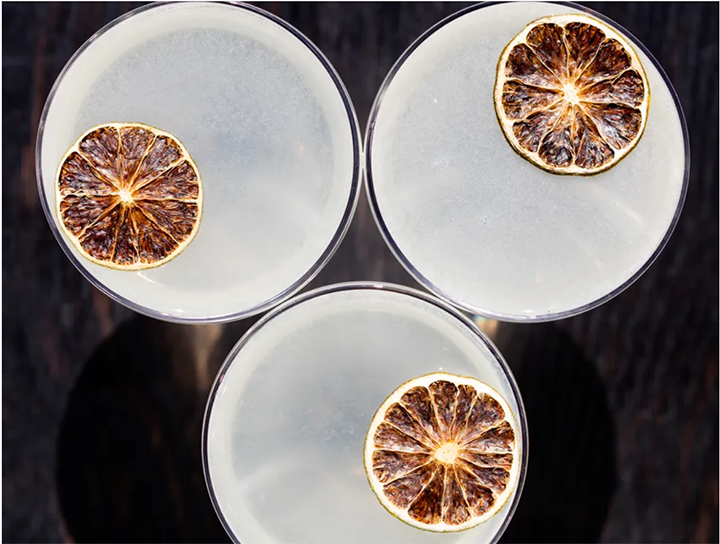
Daiquiri+: Caña Brava Rum, Clément Première Canne Rhum, lime juice, salted lime cordial, yuzu vinegar, and lime curd. Photo courtesy Naren Young for Eater
Let’s take a look at why salt is considered a magical ingredient in the world of mixology.
The science behind salt
Before we get into the creative possibilities, it's essential to understand salt’s scientific impact. Chemically known as sodium chloride, salt enhances flavors (such as citrus) by suppressing the perception of bitterness on our tastebuds and amplifying sweetness while simultaneously enhancing other taste sensations. This balancing act helps create well-rounded and harmonious flavor profiles in cocktails. Essentially, salt is the glue that holds a cocktail together.
“Salt can highlight savory notes as well as bring out flavors that might be hiding behind other components of a cocktail,” said Jamie Dodge, (Cul+ure Collective Hospitality Group) in an article for Liquor.com.
“I don’t think salt has a place in every cocktail,” he says. “Some drinks should be left for the ingredients to speak for themselves, while others might need that little boost from saline to help showcase certain flavors.”
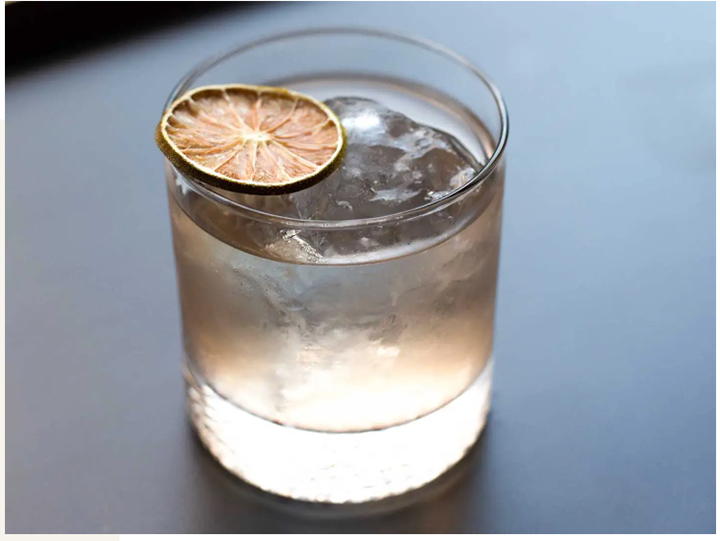
Grey Gusano: mezcal, Ancho Reyes Verde liqueur, rhum agricole blanc, fresh lime juice, simple syrup, Townshend’s Distillery Bluebird Alpine liqueur, sal de gusano, and Scrappy’s Firewater Tincture. Photo courtesy Saveur
For example, salt can temper the sweetness in a Manhattan or Negroni, while it can amplify the fresh citrus in a daiquiri or gimlet.
Bartenders can look at salt the same way they might bitters: a few drops can go a long way toward rounding out the rough edges of a drink.
“A lot of mixologists refer to bitters as the salt and pepper of cocktails,” Boudreau says, “but I believe salt is the salt of cocktails and bitters are more like pepper—both play an important role to a balanced, delicious cocktail.”
Salt can also help to increase the flow of saliva in the mouth, which in turn will make any drink feel slightly more viscous or rich, according to an article from Serious Eats.
However, the full effect salt has on a drink really depends on the other ingredients it’s joining: citrus becomes brighter, drinks with egg white become more aromatic, and beverages topped with sparkling wine get a bit sharper, according to an article from Punch.
“I've recently been experimenting with a more cooking-oriented approach to cocktail development, where certain elements in a cocktail act as seasoning agents as opposed to full blown ingredients," said Devon Tarby (Proprietors LLC) in an article for Eater. "Simply put, salt makes ingredients taste more like themselves," she continues. "Salt isn't just for savory cocktails, either. The addition of a small amount of salt helps brighten citrus and delicate flavors like fresh herbs and light fruits, dampens bitterness, and acts as an overall bridge between powerful booze and the more subtle non-alcoholic ingredients we tend to mix it with."
Harnessing the power of salt
When incorporating salt into a cocktail, there’s several ways to approach it.
“Salt is an underutilized ingredient in most bars. Just like in food, it can really enhance and bring out the flavors of all the ingredients in a cocktail,” says Gui Jaroschy (Unfiltered Hospitality).
The finishing touch
Granulated salt can be looked at much like sugar: utilizing it in its granulated form is much more limited given the fact that liquids mix better with liquids, which is why simple syrups are most often used in cocktail recipes rather than granulated sugar.
However, granulated salt still has its place in the cocktail world. Probably the most common use of granulated salt in cocktails is to rim the glass.
“Salt rims are nothing new, but they are a great way to add texture and another dimension to a cocktail,” Jaroschy says.
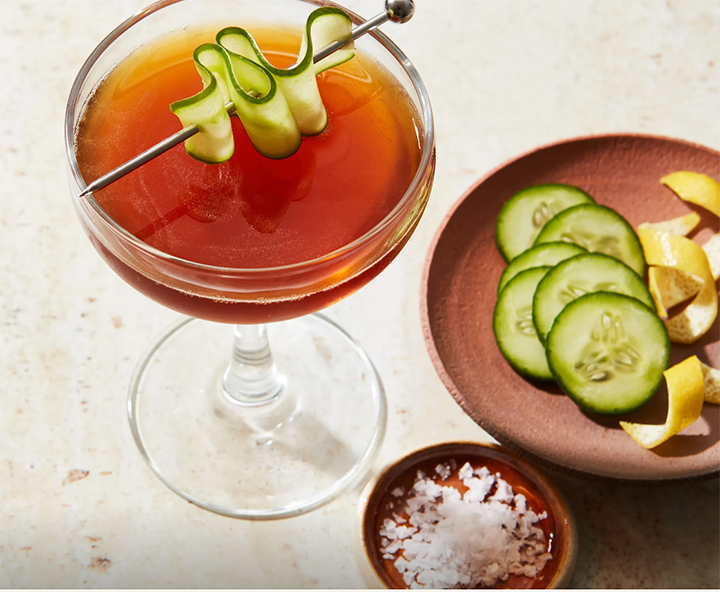
Black Angel: cucumber, kosher salt, gin, Averna, and lemon. Photo courtesy Epicurious
The most classic example is a margarita with its salted rim, adding a contrasting savory element to the drink's tangy sweetness. The salt rim not only provides a visually appealing presentation but also introduces a subtle salty note that complements and balances the overall flavor profile.
“I was never a fan of salt on the rim until I really understood what it was there for—making flavors pop—and it also makes you want to go back for another sip faster,” said Dodge in the Liquor.com article.
While salt rims are most popular in agave spirit cocktails (such as margaritas or palomas), a rim of cocoa nib, salt, and sugar can work beautifully with a bourbon cocktail.
Beyond the classic salt rim, granulated salt can also be sprinkled over a cocktail as a finishing touch.
Bartenders have also started experimenting with salt infusions to create unique and complex flavor profiles. By infusing salts with herbs, fruits, spices, or even smoke, mixologists can impart distinct characteristics into their cocktails. For example, a smoky salt infusion can add a hint of complexity to a whiskey-based cocktail, while a citrus-infused salt can brighten up a refreshing gin and tonic.
“We enjoy making flavored salts that don't just add salinity, but also help the drink tell a story,” says Jaroschy.
Salty solutions
On the opposite end of the salty spectrum, saline solutions, sprays, and tinctures have gained popularity in the cocktail world. These solutions offer precise control over the amount of salt added to a drink, allowing for consistent results. A few drops of saline solution (made by dissolving salt in water) can work wonders, enhancing the flavors and creating a more rounded and balanced taste.
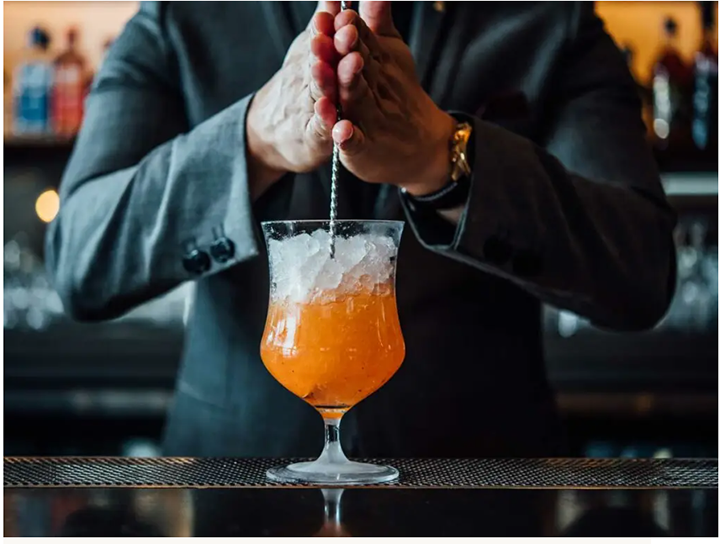
Jungle Bird: white rum, passion fruit liqueur, Campari, falernum, lime juice, saline solution, and mango syrup. Photo courtesy Saveur
To further explore the versatility of salt in cocktails, bartenders have also begun crafting salty syrups and tinctures. These concoctions add a concentrated burst of saline goodness to drinks. Salty syrups can be made by dissolving salt in simple syrup, while tinctures are created by infusing salt into high-proof alcohol. These additions open a world of possibilities, allowing mixologists to experiment with unique flavors.
Fat washing
Rounding out the salty cocktail styles is fat washing, a technique that adds a savory flavor to spirits. To fat-wash your alcohol, you add a liquid like sesame oil or melted butter to a spirit at room temperature. Let it sit for a few hours, then chill everything in the refrigerator or freezer until the fat solidifies and can be skimmed off or better, strained through a cheesecloth. The spirit retains the flavors of the fat even after you've done the skimming. However, be aware that certain fat-washing recipes utilize oils or ingredients that may not necessarily have saltiness, which will produce a flatter flavor profile. As such, avoid using fats such as unsalted butter or uncured bacon.
“Think of what bacon would taste like if it was not salt cured. Or eating a piece of unsalted butter, there's not much flavor,” says Boudreau, “but as soon as you add salt, it becomes a completely different product.
“So, while fat washing without salt will add a richness and creaminess to your cocktail, it won’t exactly taste like much.”
Check out the above recipes to help get your bar program in on this salty trend.
"I think it’s important for bartenders to experiment with salt, as it might open up an entirely new dimension as to how you put together cocktails and flavor pairings that might not have looked too interesting in the past,” said Staffan Alexandersson, (The Tasting Room) in an article for Tales of the Cocktail.
Cheers!
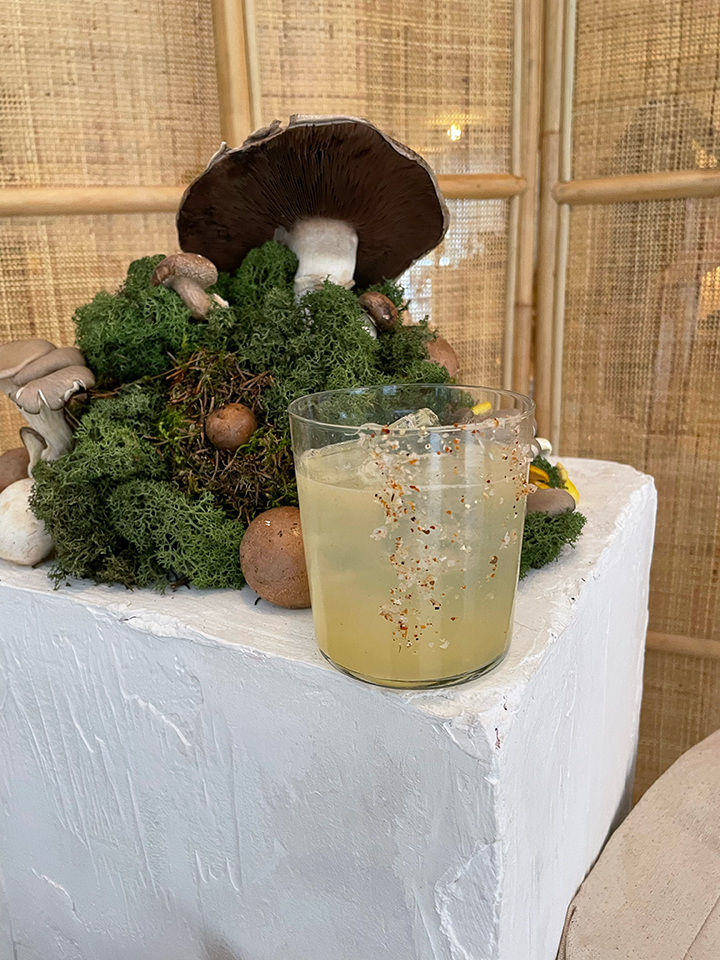
Beechfront View
Photo and recipe courtesy The Mushroom Council
Ingredients
Method
-
Use a lime wedge to wet the outer edge of a rocks glass. Pass the glass through the chili-lime salt rim to coat the rim of the glass.
-
Add the cordial, lemon, and Chili Peppah Water to an ice-filled cocktail shaker and shake until well chilled.
-
Strain over fresh ice in the rimmed glass and top with two ounces of club soda.
Ingredients for Chili-Lime Salt Rim
Method
Ingredients for Beech Mushroom & Citrus Cordial
Method
-
Peel eight medium-sized lemons, trying to remove as little of the white pith as possible. Place peels in a bowl along with sugar and muddle to release the peels’ oils. Cover and let sit overnight at room temperature.
-
The next day, use a rubber spatula to scrape the peels and sugar into a medium saucepan along with the beech mushrooms and lime juice. Gently heat to a simmer stirring every few minutes to help sugar dissolve (do not let it boil). Turn off the heat and allow it to cool to room temperature. Cover and refrigerate overnight to allow it to infuse.
-
The next day, strain out lemon peels and beech mushrooms, being sure to try and squeeze as much liquid from them as possible. Discard the peels and mushrooms and pour the cordial into an airtight container. Will keep in the refrigerator for approximately two weeks.
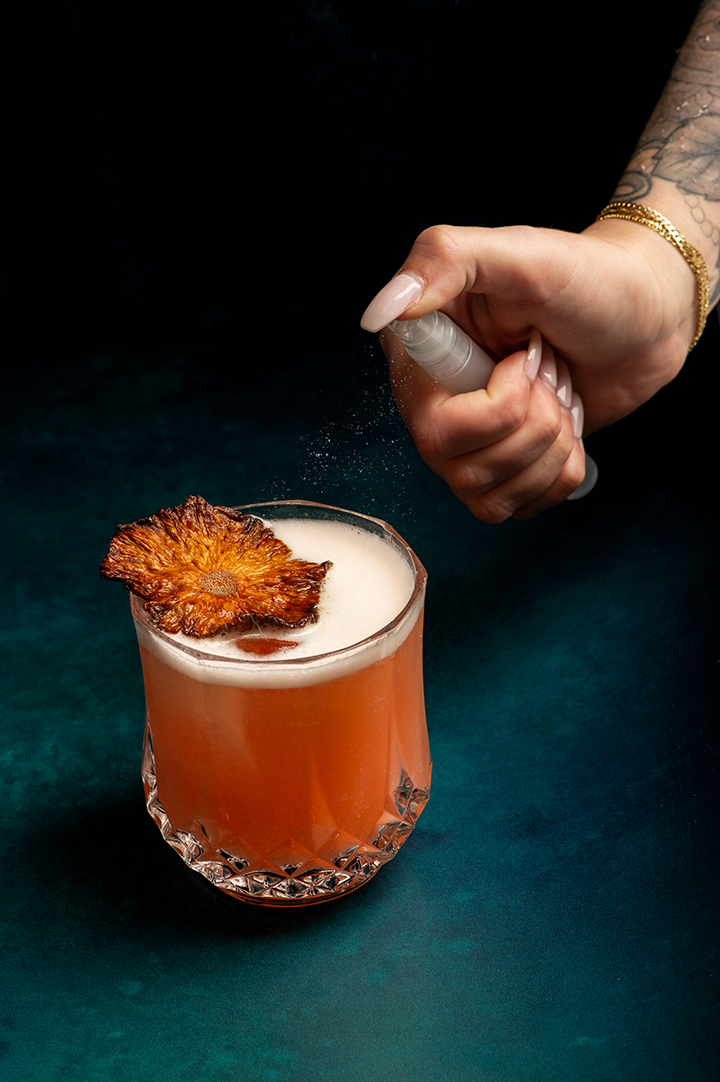
Peach Bum
Photo and recipe courtesy Shannon Boudreau, the Lazy Gourmet
Ingredients
Method
-
Combine the first five ingredients into a Boston shaker, muddle the peaches, add egg white and shake, add ice and shake again.
-
In a cocktail glass, spray to coat with saline solution, strain and serve over king cube, garnish with dehydrated pineapple.
Ingredients for Saline Spray
Method
-
In a jar add 20 grams of sea salt to 80 grams of warm water, let cool.
-
Pour into cocktail atomizer (or any spray bottle).
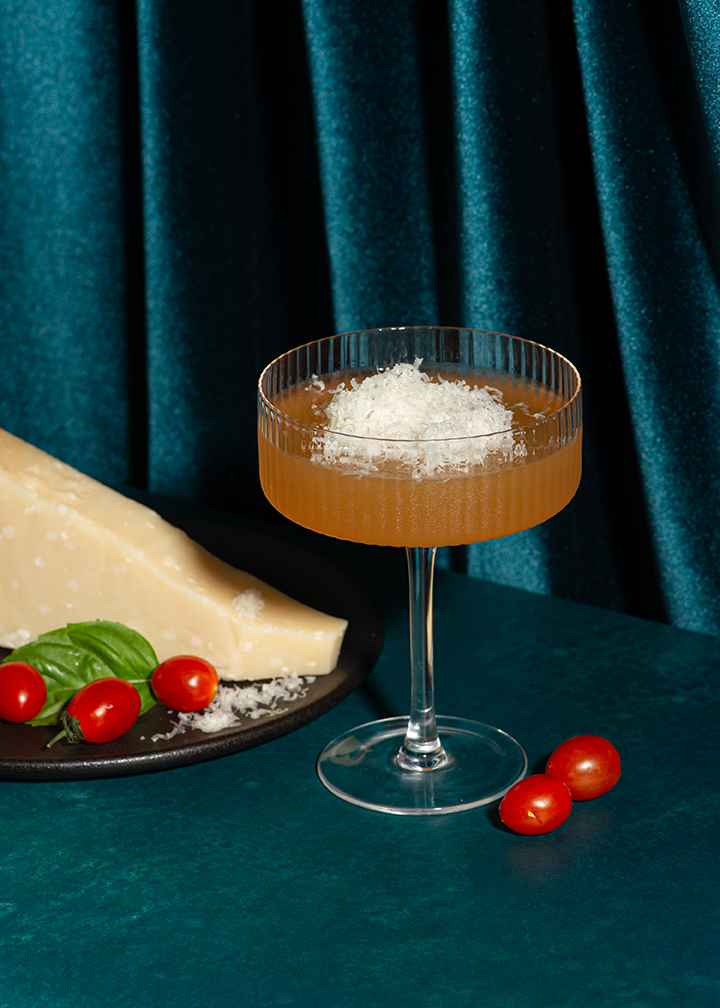
Caprese Martini
Photo and recipe courtesy Shannon Boudreau, the Lazy Gourmet
Ingredients
Method
-
Muddle all ingredients, add ice, stir, strain, and serve in coupe martini glass.
-
Garnish with fresh grated parmesan cheese.
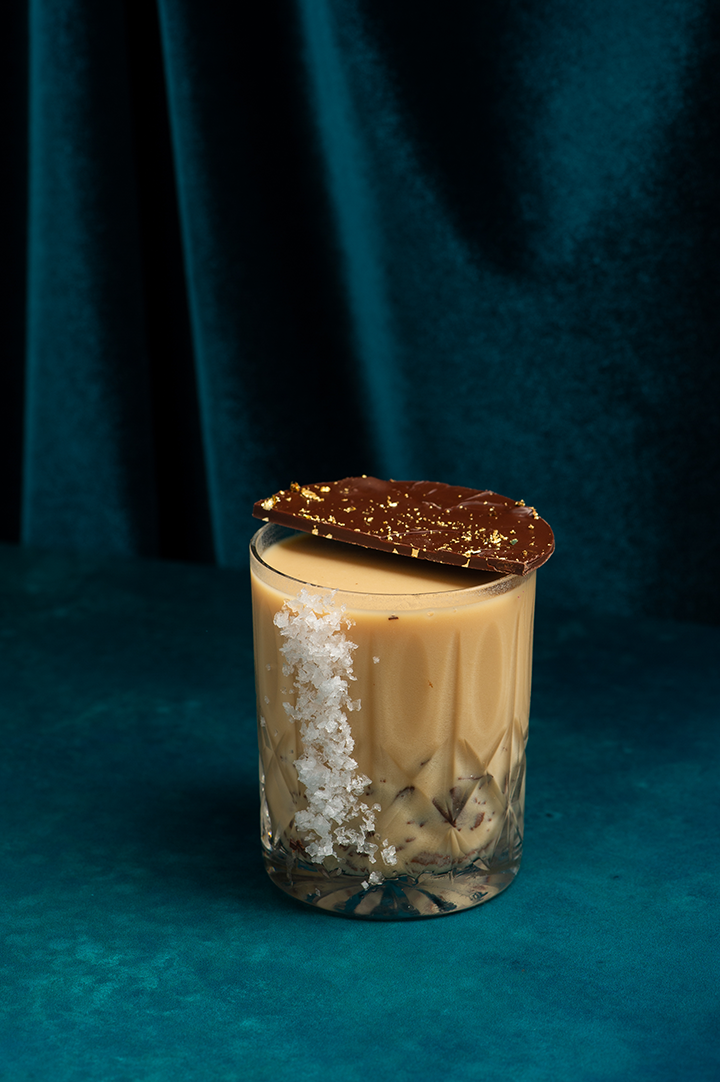
The Nutty Professor
Photo and recipe courtesy Shannon Boudreau, the Lazy Gourmet
Ingredients
Method
-
In a shaker combine all ingredients, shake for 30 seconds.
-
Strain into cocktail glass with crushed ice.
-
Garnish with chocolate shavings.
Ingredients for Peanut Butter Fat-Washed Whiskey
Method
-
Spread peanut butter across the bottom of a deep sheet pan or casserole dish.
-
Pour bourbon, rye, or unpeated scotch on top of the peanut butter.
-
Cover with plastic wrap and let sit for two days.
-
Strain with a cheese cloth until all the liquid is out. Pour it back into the bottle for use.



